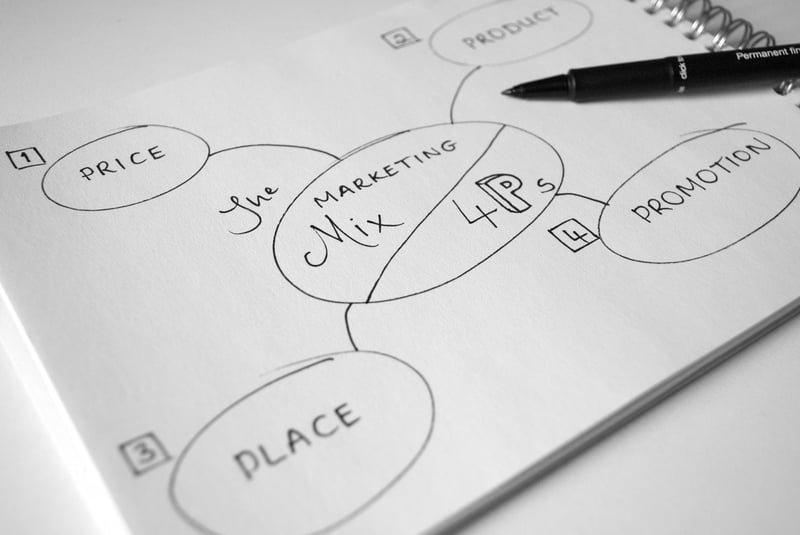Brand is essentially the perception someone holds in their head about a product, a service, or an organisation; a person, a cause, or an idea. It acts as a mental shortcut for consumers so that when they need what you’re selling, they think of you first.
Shortcuts
- What is a brand, and why do you need one?
- Getting your brand right
- Making your brand 'real'
- Branding within the business: setting your company culture
- Common mistakes when updating your branding
- Conclusion
So what about brand building? Put simply, it’s the deliberate application of effort to create the desired perception - the mental shortcut - in someone else’s mind.
Brand building has to start internally, and it has to start at the top of the business. So ask yourself this. How do you perceive your business? What do you think the business stands for?
Now, ask the rest of your board this question. Then middle management. Then everyone in a customer-facing role. We’ll bet that you get a variety of different answers. Many business leaders find their perception of the brand or the company doesn’t filter down to the rest of the business. If your employees don’t know what your business is all about, what chance do your customers have?
In this guide, we’ll lead you through the basics of branding - what it is and why it matters. We’ll show you how to establish your current brand values and implement a vision that changes them; how to pick the right channels to communicate your message and set a company culture that makes it ring true. And finally, we’ll run through the major mistakes we see businesses make around branding activity, so you know what to avoid doing.
All of this will pay off at the bottom line. Research indicates that brand management has a predictable, meaningful impact on every aspect of customer lifetime value: acquisition, retention and profitability all improve if your brand is consistent and positive, and decline if your brand is incoherent or neglected.
What is a brand, and why do you need one?
This simple question occasionally baffles business leaders who are taking their first serious look at branding and marketing.

The most crucial thing to understand is this: every business has a brand, even if it has made no effort to create or curate one. Everything your business does, every touchpoint between the business and the customer, every interaction and every transaction contributes to your brand.
As those elements accumulate, your business will build brand equity - the value it has over its competition in the minds of clients or customers.
Brand equity can be positive or negative - and often, it’s both at the same time. Think about Amazon: the e-commerce giant has positive brand equity as ‘the everything store’, able to sell more or less anything and deliver it fast, and negative brand equity as an avoider of taxes, an exploiter of workers, and a fund for owner Jeff Bezos’ bizarre vanity projects.
As a response, brand managers at Amazon have attempted to shift the conversation around some negative aspects of its brand: paying more taxes in some countries and soliciting feedback from staff. It’s an ongoing process - and there may be no managing the impact of Jeff’s private mountain with a giant clock inside it - but there’s a compelling reason for Amazon to make the effort.
Brand equity matters because positive brands are profitable brands. Research by a team of marketing professors from four major universities revealed that brand equity has a direct impact on customer acquisition, retention and conversion rates. Furthermore, marketing activities exert both direct and indirect impact on brand identities. The exact impact - increases in profitability by X or Y% - are highly variable, so there’s no universal “branding will boost profits this much” truism that stands up, but as a generalisation, the results of our marketing activity bear the claim out.
Getting your brand right
Building a great brand is a long term, complex process, but there are three central pillars around which the rest of your branding activities revolve.
1. Brand values - what your brand stands for
Brand values are the starting point for marketing activity. When our Marketing Directors arrive at a business, they conduct a workshop in which they search for the core values of the organisation. Once those are well defined, the business’ leaders can establish a clear vision for what they want the company to be and do.
Brand values have to be more than superficial claims; they have to be borne out in how the business operates. If you’re pushing eco-friendliness and sustainability as brand values, but you don’t have paper recycling bins in the office, your business vision is hypocritical. Your employees will treat it with the cynicism it deserves, their treatment of customers will reflect that cynicism, and eventually, your customers will recognise how hollow your ‘eco-friendly’ business is.
2. Brand audits - where your brand is now
Often, our Marketing Directors find that companies are either spending too much money on their brand and not seeing return on investment, or they’re seeing their brand equity decline and they can’t establish where the value is going. Sometimes, the business simply doesn’t know what it stands for - the early vision has been lost in the daily grind of getting products and services to people.

A brand audit is how a business starts to get its brand back on track. Nine times out of ten, it’s best left to a third party. An insider often has their own sense of the brand’s values, however muddled and hard to articulate they’ve become; outsiders have the perspective to appraise the brand as it is, not as they’ve experienced it during their day to day. The process itself, however, is fairly straightforward. The brand audit looks at:
-
Brand positioning. Where does your brand stand in relation to its competitors? What differentiates you from them? What do you stand for that they don’t?
-
Brand awareness. How often do people talk about your brand? In what context? Do people know your product or service by name?
- Brand engagement. How are people talking about you? We’re not talking about automated journals or Twitter bots - we mean value-added discussion that takes some effort, like editorials, reviews or responses to your business’ operations.
By taking time to understand what you think your brand stands for, and comparing that to what your customers think it stands for, the brand audit highlights where there’s room for improvement in your branding activities. Digging down into awareness and engagement statistics reveals how different demographics perceive you, relative to the rest of the industry. Do they talk about your product in the same terms you do? If not - why not? And what are you going to do about it?
3. Customer insight - what your target market believes about your brand
Your own perceptions are only half of the game. Ferrero Rocher’s brand may have a pretence to class and glamour, but Ferrero Rocher’s product is on the bottom shelf at Happy Shopper, across the aisle from the dirty magazines. Does the buyer really think they’re fancy?
The disconnect between customer understanding and product/service has an impact on the bottom line. Ferrero’s bestselling product is actually Nutella, which isn’t burdened by the same branding inconsistencies: it’s an indulgent product, but an unpretentious one, and is positioned as such. It’s also bucking an overall decline in chocolate sales.
In a real and definite sense, your brand stands for what your customers believe it stands for - and you need to understand what your customers think of you before you can start to change it.
Building customer insight demands a similar level of analysis to the brand audit. The process goes like this:
-
Establish what you already know. This stage is a data audit - look at what you already know about your customers, your target and most successful segments.
-
Define the scope of your research - which, in this case, is what your customers want your brand to stand for and what they want your product or service to provide.
- Choose your method. Online surveys, telephone interviews, focus groups, vox pops - go out there and ask questions about what your customers think of you, and what specific actions could change their minds.
It’s important to establish specifics, and to keep an open mind. You’re going to hear some things you didn’t expect, and more than a few you didn’t want to. Remember, you’re seeking out this information so you can change the way customers feel about your brand - which means you need to know where to start.
Making your brand 'real'
Marketing, customer services and sales - the customer-facing aspects of your business - are the body language of your brand. They’re how you express and execute your brand values in the real world, making them more than just words on a mission statement.
Choosing the right communication channel for your business is make or break time for any marketing endeavour, and brand building is no exception. No matter how good the materials are, if they’re not put where the target audience will encounter them, they’re useless.

PR tells your brand’s story with confidence and credibility, raising your profile and positioning you within the sector at large; it allows you to stay on top of brand equity and control the narrative surrounding your business. But it can’t do everything.
Whether you need to focus on advertising, direct mail, telephone marketing, print media, email marketing, social media, trade shows or videos is beyond the remit of a general overview like this one. Many of those channels break down still further: Pay Per Click advertising is its own affair, quite discrete from advertising through sponsorship of content or events. Social media is notoriously fragmented: marketing that works on Twitter is not the same as marketing that works on Facebook, and some businesses should be on LinkedIn instead.
Your choice will rest on your customer segments and personas - who you’re trying to sell to and where they spend their time. You’ll have to tune your approach over time, based on the ultimate measure of success - Return On Investment (ROI). Where are you seeing the value-added discussion that builds your brand? Focus your resources there.
The marketing channels you choose aren’t the only way you communicate, however. Sales and service personnel are a channel in their own right. The way they treat customers, the tone of voice, the customer experience as a whole: they’re all ways in which your brand values reach your customers. In fact, they’re among the most direct ways: to go back to our body language metaphor, they’re the facial expression and the strength of your handshake, the elements that suggest your values are really authentic.
First Direct is great at this. The bank’s customer service is a repeated award winner, precisely because it creates authentic, positive memories. Humanity is at the heart of First Direct’s customer experience: according to head of brand and marketing Zoe Burns-Shaw, it saturates everything from “our amazing reps [or] the language used in a welcome pack [to] the way a product is designed or a digital interaction”.
Alex Luff, director of Rarefield, explains that brand value builds up through repeated encounters. Each touch point adds to a schema - a set of logged experiences and feelings that shape future responses to the brand. What this means for brand building is very simple. You will need to communicate through more than one channel. Brand equity builds up across multiple encounters between customer and brand, so you’ll need to engage in multiple places and on a regular schedule to nurture and sustain customer loyalty.
Your brand’s message will also need to be consistent. If you’re presenting yourself on social media as a luxury brand, you can’t have your direct mail pushing low prices. Tailoring your message to a channel is about saying the same thing in a different way - not about saying whatever it takes to close the sales.
The four Ps and brand building
Classical marketing theory divides marketing activities into four categories: product, price, place and promotion. While modern thinking has moved on (to seven categories of marketing, clustered around four pillars), the original four pillars still provide a model that’s of use to brand builders.
Product innovation has to be aligned to actual customer needs, offering something people want. Watching the trends and deciding that your next clothing release needs to be shapewear or your next watch minimalist is all well and good, but you need to know whether your customers want and trust you to produce it - and if not, what do they think you can do?

Price is another key element of a strong brand. How much you charge for a product or service indicates how much you think it’s worth; it also suggests who you want to buy it, whose values your business is aligned with. Lower prices say ‘affordable, accessible’, but also ‘cheap and cheerful’, and to some consumers - who equate higher prices with higher quality - it suggests a second-rate offering.
Place feeds into consumer reception and perception in the same way. Where you sell - the specific marketplace to which you’re bringing your product - is a decision that goes hand in hand with how much you charge. In retail, an upmarket arcade and an industrial estate broadcast very different brand values; a handful of showcase items says something that stacking high and selling cheap doesn’t.
Promotion is the final element. Assuming that everything else is lined up as it should be - you’re selling what your target demographic wants, at a price they think is fitting, from a place they want to be seen buying from - you still have to differentiate your product or service somehow, standing out from the buzz of everyone else’s marketing. Differentiation is why Dell’s Alienware brand laptops glow and the corporate models they sell under their own name don’t, even if the hardware is more or less identical: it’s a needless luxury that suggests raw power, and aligns the product with the premium price Dell want to charge.
Branding within the business: setting your company culture
Branding is a hollow exercise if it doesn’t permeate your entire business. As we’ve already seen, without the customer-facing aspects - marketing, sales and service - living and breathing your values, they’re just words on a page.
Every aspect of your operations needs to be on-brand to make sure your values are being communicated truly, accurately and honestly to your customers. Your brand starts with your company culture - one of the most mutable and hard-to-define aspects of a business - and company culture starts at the top.
You, as the business leader, and the rest of the board or management team, must be able to explain what your business does and stands for at the drop of a hat, and go beyond the products and services you sell. What do you do for your customers? How does your business improve the world by being in it? What does ‘improve the world’ mean, from your business’ point of view?
Leadership doesn’t exist in isolation. Business leaders have to be actively engaged with their people, modelling the behaviours that express the values they want to see. They also have to listen to their employees. If your employees are working in cramped, isolated, overlit offices, they’re not going to be open-minded team players. 
This isn’t to say that an open plan, naturally lit office is the perfect solution: it may well be that your employees value confidentiality and the comfort of their own space, and can pass those values onto customers if they have a personal office in which to meet, greet and do business.
The only way to find out is to engage with them and secure honest feedback. Face to face interactions won’t always do this - people want to keep the boss happy, and no matter how much you say you want to hear the truth, the power dynamic will always be in play. Anonymised surveys are your friend here: they allow your people to say what needs to be said, without fearing that it’ll come back to haunt them somehow.
Like a brand, company culture is often something that businesses struggle to articulate - it’s hard to see the wood for the trees. Rebranding within your business, building the company culture you want to communicate to your customers, has to start with a frank appraisal of how things are at the moment.
These questions will help you establish your current company culture - what your employees think is important, what they can’t help but see as a negative, what opportunities they think you provide.
- What five qualities should a new employee have in order to fit in?
- What makes you proud to work at this company?
- What process could be fixed or improved?
- What do you need help with? On a daily basis? On a monthly basis?
- What’s causing you frustration or delays in your work?
- Looking back on this week, what would you like to see improved?
- How do we support your professional development and growth?
- What’s one thing you could change about the company if you could?
As with customer insight, you have to be prepared for home truths that you might not want to hear - but you need to hear them in order to build the business you want to lead. Of course, refusing to hear the truth is only one way for your brand building to go wrong: there are other common mistakes of which you need to be aware.
Common mistakes when updating your branding
Brand building isn’t easy, and it isn’t always clear what a business needs to do. When our directors join a business that needs to work on its branding, they tend to find the same problems coming up again and again. We see five major branding mistakes on a regular basis when a company embarks on updating their brand: they are as follows.

1. Confusing brand problems with business problems
Business owners spend a lot of time thinking about their business - and living and working in such close proximity can mean they lack perspective. If a business is experiencing major barriers to growth, working on the brand won’t necessarily tackle the root problem. It’ll certainly give the impression that the business is working on itself, but it’ll only be an impression. Branding without substance behind it is nothing but an empty promise.
2. Neglecting existing brand equity
This mistake stems from a belief that branding means nothing but logos, taglines and colour schemes. In truth, a business’ brand extends into its premises, its employees, and its workplace culture; its products, services and prices. The visual signifiers of the brand call all those things to mind - and changing those signifiers of the brand means throwing all those associations away.
3. Underestimating the size of the job
This is the other consequence of misunderstanding how deeply your brand permeates your business. It takes a week or two for a designer or agency to produce a new logo and mastheads; it takes months to establish a mission, vision and values, and realign the company’s culture along those lines. A full rebrand is a big deal - it may be wiser to refresh one element at a time, within the confines of a larger brand strategy.
4. Not getting team buy-in
An effective brand should affect every aspect of daily operations - including how employees greet customers, write emails, answer the phone and respond to reviews and social media. This means the employees need to buy in to the brand’s new values - and to an extent, those values need to come from how staff choose to act and the values they already hold. Imposing new values from the C-suite and expecting staff to adopt them is unrealistic.
5. Crowdsourcing your decision making
While you ideally want to build your brand on the values and beliefs of your employees, it’s also important to establish boundaries and have a clear vision of your own. At the end of the day, business leaders do have a perspective on the whole business, and are aligned to that business’ future - that’s what being a leader means.
That leadership perspective has to guide the branding project as a whole, leading the business from where it is to where it should be.
Conclusion
A successful brand is hard to define.
Some say the best brands have a thorough understanding of their target market, their interests, and how they communicate. Others claim it’s being on the consumer’s side and making them feel the right things that counts. For our money, it’s something a lot more practical. Consistency is the most important thing.
There are lots of things you need to do - and do continually - to build and maintain a good brand. From the brand audit and the setting of brand values, through to the consultation with customers and employees that sets your company culture, you as the leader of the business have to look at and listen to the current state of affairs.
You need a vision that you can communicate clearly, simply and directly, through actions as well as words - and you need to know where that vision’s target audience will be most receptive to hearing it.
You’ll know when you’re doing it right: productivity will be up, operations will be efficient, customers will be satisfied, and you won’t struggle to explain what your business stands for - your brand will speak for itself.




